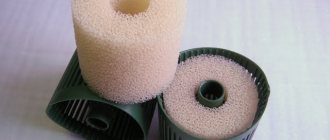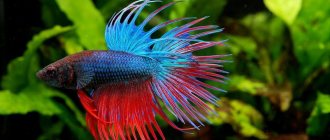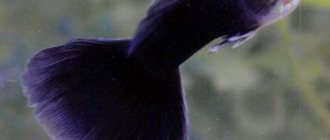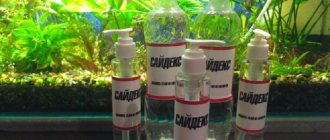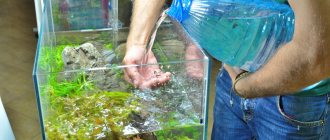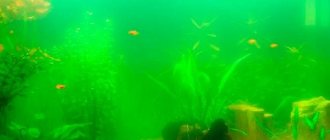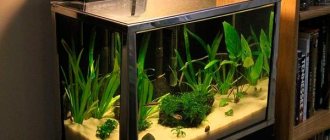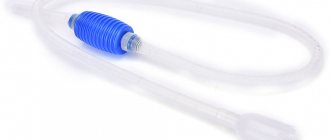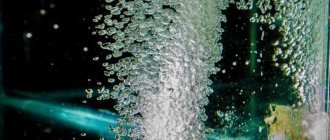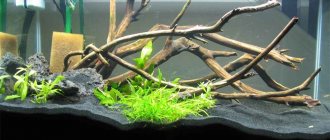In the aquarium industry, various drugs are used to treat and prevent diseases. These include methylene blue. It is a monofunctional product used for many purposes, such as disinfecting aquarium water or dyeing cotton. More information about the use of the drug methylene blue for aquariums and will be discussed in this article.
Methylene blue: application in the aquarium
What is the substance?
To understand what methylene blue is and what qualities it has, consideration of the external data of the drug and its properties and capabilities will help. This product of synthetic origin in its pure form is dark blue crystals, which can sometimes have a greenish tint. It is not resistant to light, so it is recommended to turn off the aquarium lighting when adding it to the water.
The qualities that blue has are fungicidal and disinfectant. Therefore, blue is widely used for the treatment and prevention of fungal and parasitic infections, disinfection and rapid healing of mechanical damage to fish tissue and restoration of their cellular respiration.
Notes
In different sources you can find discrepancies in the amount of the drug applied, despite the fact that the concentration of methylene blue may not be indicated in the instructions of the manufacturer of the aquarium medicine. For example, when adding the drug from AVZ, the water turns out to be much lighter than from Zoomir.
Dosages vary so much that it may seem like a mistake. AVZ recommends adding its methylene blue solution for five days in an amount of 2 ml per 100 liters of water. And in industrial fish farming, they generally make baths of 200 mg of powder per 1 liter of water for seven days!
If you understand treatment regimens from different sources, you can get confused. You shouldn't be scrupulous about this. The dosages are so free that with the acquisition of a little experience, methylene blue can be poured “by eye”, guided by the color of the resulting medicinal solution.
In what form is it used for aquariums?
The disinfectant in question, with a wide range of applications, is available in the form of powder and crystals with a characteristic shade. Methylene blue is used as a conditioner for cleaning surfaces and water in aquariums. The qualities of the air conditioner guarantee quick cleaning of the water container from pathogenic microorganisms, eliminating the risk of illness for fish and other aquatic inhabitants.
The product in the form of an air conditioner can be used in its pure form, since a ready-made composition is offered for sale. It comes with detailed instructions for use, which allows you to achieve a pronounced positive effect of the drug on the body of aquatic animals and fish.
Description of the drug
Methylene blue is a medicinal dye consisting of a dark green crystalline substance. The substance has bactericidal properties and is highly soluble in liquids, so it is used in various fields:
- For dyeing fabrics.
- In medicine for the treatment of certain ailments.
- In the aquarium industry, for treating fish and cleaning the aquatic environment, which is called disinfection of an aquarium with fish.
Methylene blue is available in powder or crystalline form and is sold in pharmacies. For fish in aquarium keeping, an aqueous solution is used, which can be purchased at pet stores - the product is bottled in 50 ml bottles for ease of use.
Methylene blue is often used by aquarists to purify water and treat fish, since the drug allows you to quickly and effectively destroy parasites. However, in order not to harm your pets, you should know how to properly use blue aquarium conditioner.
Manufacturers recommend storing the product in a dark, dry place at temperatures up to 25C. It is important that children and pets do not have access to the storage area.
Qualities of methylene blue conditioner
Among aquarium lovers, the drug in question is considered one of the mildest and most effective. It is easy to use; just follow the rules given in the instructions for use. The effects of air conditioning are varied:
- The drug kills parasites, fungi and protozoan bacteria that can cause the death of your pets. Disinfection of water occurs with the rapid destruction of parasites such as ichitophthirius and chylodenella.
- The conditioner also provides more active cellular respiration of fish tissues due to its donor-acceptance properties. As a result, the fish become less sensitive to various external adverse influences, and the process of caviar formation improves. It is especially important to restore the cellular respiration of aquarium inhabitants during prolonged oxygen starvation, which can occur, for example, during long-term transportation of fish.
- Blue aquarium conditioner copes with the task of disinfecting already laid eggs. If blue is added to the aquarium directly in fish food, the effect of the drug becomes milder and the incubation of eggs is accelerated. The fish eat the food with appetite, since the drug does not change the taste of their usual food.
- External injuries and negative changes in the condition of the fish are eliminated: the appearance of “fluff” on the surface of their body, cuts, deterioration in the appearance of scales, white spots, pimples and excessive mucus.
This drug can be used for both treatment and prevention of diseases. Methylene blue should be added to the aquarium in a certain way in order to obtain the desired result and not harm its inhabitants.
Instructions for using the air conditioner
Every aquarium owner strives to preserve the health of its inhabitants and make their aquatic world brighter and more prosperous. Methylene blue for fish will be the best solution, because its qualities guarantee a safe effect on the body of all types of aquatic inhabitants and rapid and long-term purification of water. However, to prevent possible negative effects, the instructions for use of methylene blue should be carefully studied.
There are features for treating water and aquarium inhabitants living in fresh and sea water. Taking them into account will help maintain the health and activity of fish for a long time, and prevent their infection and death.
Aquarium use options
Methylene blue is one of the few products that every aquarist should have in their arsenal. This drug has a number of useful properties for any artificial reservoir and its inhabitants:
- Kills single-celled parasites;
- Treats fungal diseases and lesions of the mucous membranes of fish;
- Disinfects water and improves its quality;
- Fights the effects of cyanide poisoning;
- Promotes faster and healthier growth of caviar;
- Eliminates problems with tissue respiration in animals;
- Allows new fish to adapt more easily when introduced into the aquarium or when transplanted.
How to treat water in a freshwater aquarium?
The most common option for keeping fish is in fresh water. Such fish are less demanding in terms of living conditions, and their cost is more affordable than their marine relatives. A freshwater aquarium is quite easy to handle. Methylene blue is used in diluted form: before application, the substance is mixed with water. The amount is calculated as follows: for 50 liters of water in the aquarium, take 20 drops of the product, which is approximately 1 ml of the original substance. The required volume is mixed in 100-200 ml of water and only then poured into the container. It is necessary to add methylene blue in the form of a prepared solution in small portions.
Disinfection is carried out within 5 days; after this time, the water in the aquarium must be changed. You can completely remove the composition from the water by adding activated carbon to it, which further disinfects the environment.
The drug solution is added to the water container in which the fish live. The eggs can also be safely treated with an aquarium grade methylene blue solution.
Indications for use and properties
The use of methylene blue in an aquarium allows aquarists to quickly and effectively disinfect the aquatic environment in the tank. The product can be added directly to the water to prevent disease and prepare the aquarium for new residents.
The undoubted advantage of the drug is that aquarium fish tolerate methylene blue well, since it is safe and sold at a favorable price. When used, the product has the following effects on the aquatic environment:
- Improves liquid quality.
- Eliminates fungal diseases.
- Cures against single-celled parasites.
- Promotes better development of caviar.
- Reduces stress in fish when moving to a new container.
Most experienced aquarists use methylene blue as a preventive measure when transporting and moving fish to a new tank to reduce stress in their wards. In addition, the drug also eliminates the possibility of pathogenic fungi and parasites entering the aquarium.
Treating a seawater aquarium
If necessary, to purify the water and disinfect the marine inhabitants of the aquarium, an aqueous solution of methylene blue is also used. However, unlike freshwater fish, they will need to be placed in a separate container first. A solution prepared at the rate of 20 drops (or 1 ml) of methylene blue per 10 liters of water is added to it.
Marine fish are placed in the prepared solution for 3 hours, during which many single-cell parasites will be destroyed from the surface of their body, tissue injuries will be disinfected and cellular respiration will be improved. As a preventive measure, blue can be added to the water once every 1-3 months.
Methylene blue: disadvantages
Of course, methylene blue cannot be called an ideal drug, even despite the large number of advantages. Let's look at the main disadvantages of the drug:
- changing the color of decorative elements in the aquarium ;
- painting the soil and walls of the aquarium blue;
- decrease in the efficiency of the biofilter after using the drug;
- oppression of aquarium plants (their condition greatly worsens).
Methylene blue has its disadvantages.
To avoid side effects, it is better to use the drug in a separate container. This will protect the aquarium with decorative elements from changing color. When treating water in a community aquarium, it is advisable to remove all elements from it before adding an antiseptic solution. 3-4 days after the course of treatment, the walls of the tank should still be cleaned.
How to fix moss, anubias, bucephalandra in an aquarium
Nitrates in the aquarium: how to reduce, check, fight and maintain
The smallest aquarium fish: types and care for them
TOP 20 most beautiful aquarium fish
TOP 12 most expensive aquarium fish
Aquarium fish that do not spawn, but give birth to fry
The water in the aquarium becomes cloudy: the reason, how to eliminate it
Heater for an aquarium. Temperature in the aquarium
Things to remember when treating with methylene blue
Having chosen the product in question for regular treatment of the aquarium, it is necessary not only to study the instructions for its use, but also to learn about the features of use. In an aquarium, methylene blue can, along with improving the health of its inhabitants, cause the following changes:
- paint the walls of the vessel if it is made of plastic;
- give color to some objects inside the aquarium, primarily those that have large pores and light color (for example, natural stones, corals);
- destroy the balance of nitrogenous compounds contained in water.
Having the ability to completely remove protozoan parasites and fungi from the aquarium and the fish’s body, blueing requires taking into account the specifics of its effects. Therefore, before using the drug solution, light, easily stained objects and decorations should be removed from the container so that they do not change their shade and lose their attractiveness.
Therapeutic baths
Blue baths are good because they contain a high concentration of the drug, which makes it possible to eliminate diseases in a short time. The procedure is performed once for mildly affected fish, or twice with an interval of 2-3 days for a severe stage.
To prepare a therapeutic bath, settled water of a suitable temperature is poured into a separate container, after which the liquid is filled with oxygen using an aerator. Blue is added at the rate of 1.5 ml/1 liter of water, thoroughly stirring the product until the water turns blue. The length of time the fish stays in the bath is 30 minutes.
